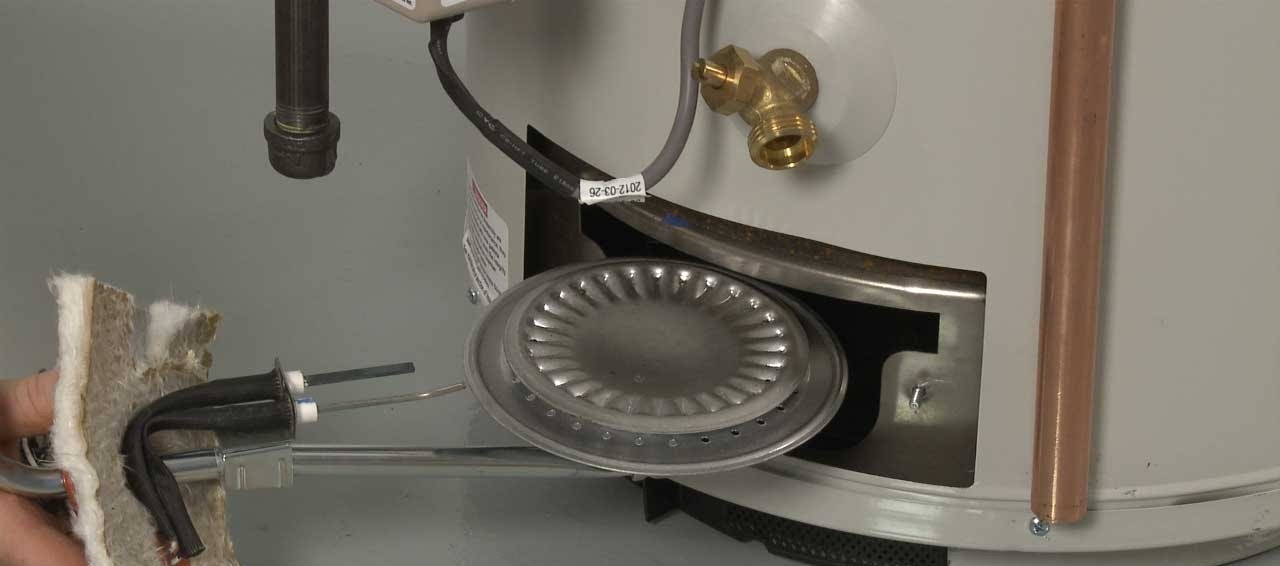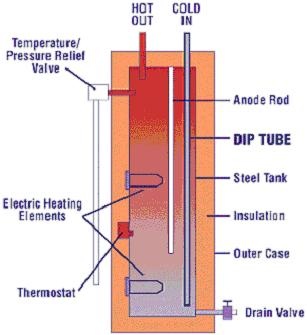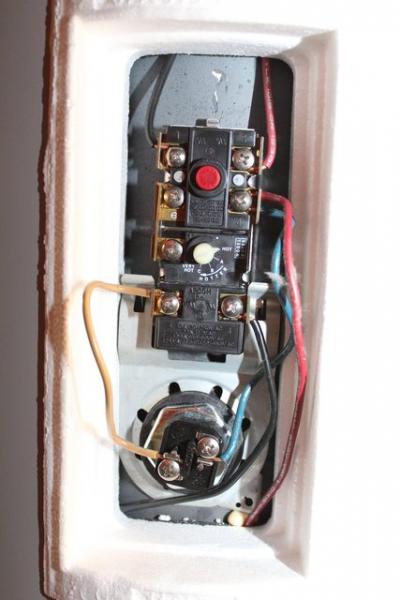When we hear the phrase “water heater,” most of us probably get a picture in our heads of the traditional storage water heater. Although many other types of water heaters are now available, the standard storage water heater remains the most commonly seen in homes across the United States. A storage water heater consists of a tank or reservoir that holds water. A pipe brings cold water into the tank, where it is heated. Warm water rises to the top of the tank and is disbursed through another pipe whenever hot water is needed throughout the house. Storage water heaters all do basically the same thing, they just use different sources of energy for heating the water. Let’s take a closer look.
 Basic Structure
Basic Structure
The basic structure of a storage water heater is pretty simple. The visible part — the drum — is a tall cylindrical tank made of heavy metal, a layer of insulation and an outer shell. Tanks hold 30 – 80 gallons of water, depending on size. Coldwater enters the tank through the dip tube. The end of the heat-out pipe lies near the top of the tank, ready to whisk heated water wherever it is needed. Other essential parts of each storage water heater are the thermostat, drain valve, pressure relief valve, sacrificial anode rod, and a shut-off valve. The heating mechanisms differ in how they supply the heat needed to warm the water. We’ll look at gas water heaters first.
Gas Water Heaters
Gas water heaters, as the name implies, use natural gas or propane to fuel the heat for your water. The heating system for this type water heater has two main parts: the burner and the venting system.
 The Burner
The Burner
The burner sits beneath the tank in a small chamber. This burner operates on the combustion principle. Gas — either natural gas or liquid propane (LP) flows through a valve into the burner. A thermostat located outside the tank projects a heat sensitive probe inside the tank. The thermostat controls the flow of gas to the burner. Combustion occurs when the pilot light ignites the gas flowing through the burner. Flames heat the bottom of the tank, transferring heat to the water inside the tank. Small openings in the combustion chamber allow air to enter.
As long as gas and air continue to flow into the combustion chamber, the burner will continue to heat water. Thermostats are generally set between 120 to 180 degrees Fahrenheit , although newer models may restrict the upper limit to 150 degrees Fahrenheit. An energy cut off switch acts as a safety mechanism within the thermostat. If the probe detects water temperature above 190 degrees F, the energy cut off valve shuts off the gas flow. If this happens, you usually have to replace the entire gas valve mechanism. The combustion process, though very efficient for heating, produces harmful fumes and requires proper venting.
 The Venting System
The Venting System
Carbon dioxide, carbon monoxide, and nitrogen oxide produced in the combustion process are harmful to breathe. They must be vented outside the home or office to protect the people inside the buildings. Gas storage water heaters use a flue and hood venting system. The flue consists of a bottom hood within the combustion chamber. This hood collects and directs the exhaust fumes up through the flue. The flue itself is a small tube rising through the tank and exiting at the top. Many flues now contain baffles. A baffle is a shaped like a helix. It deflects the exhaust push the heated air to the sides of the flue to help heat the water. Exhaust exits the tank through the draft hood located just above the top of the tank. The draft hood prevents back drafts into the flue and vents noxious gasses outside the home or office.
Electric Water Heaters
 Electric storage water heaters have the same basic parts as their gas-fueled cousins. Rather than heating water with fire, though, electric water heaters use electricity. The heating system for an electric water heater also has to main parts: the elements and the circuit control.
Electric storage water heaters have the same basic parts as their gas-fueled cousins. Rather than heating water with fire, though, electric water heaters use electricity. The heating system for an electric water heater also has to main parts: the elements and the circuit control.
The elements
The elements in this system work much like the burners on an electric stove. Elements may be stainless steel or copper-plated. They consist of a wire surrounded by filler material encased in a U-shaped tube of either stainless steel or copper. They project into the tank about one-third down from the top of the tank and one-third up from the bottom. Each element has its own thermostat. As electricity flows through the inner wire, resistance in the wire generates heat. The heat passes into the filler material and outer sheath of the element to heat the water. The upper element operates first to heat the top one-third of the water to the temperature set on the thermostat. Once the upper water has reached this temperature, the lower element comes on and heats the middle third of the water.
The control circuit
 The control circuit includes the elements, thermostats, a high limit control switch, and a reset button. As in the case with the gas-powered water heater, the electric water heater also carefully monitors water temperature and pressure. If water temperature in the electric water heater exceeds the established limit, the high limit switch activates and shuts down the entire unit. You can restart the unit once it cools by pushing the reset button on the thermostat.
The control circuit includes the elements, thermostats, a high limit control switch, and a reset button. As in the case with the gas-powered water heater, the electric water heater also carefully monitors water temperature and pressure. If water temperature in the electric water heater exceeds the established limit, the high limit switch activates and shuts down the entire unit. You can restart the unit once it cools by pushing the reset button on the thermostat.
 Conclusion
Conclusion
Well, there you have it. Although both types of storage water heaters provide the same function, the do so by very different means. When you’re considering a new water heater, be sure you review all your options carefully. Both types of heater have energy efficiency and safety features built in. Just how much money you can save will depend on the needs of your family or business. Give us a call today. We’ll walk you through all the details and help you make the best choice for your particular needs.
